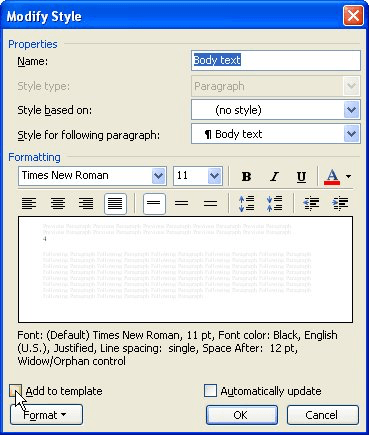Please Note: This article is written for users of the following Microsoft Word versions: 97, 2000, 2002, and 2003. If you are using a later version (Word 2007 or later), this tip may not work for you. For a version of this tip written specifically for later versions of Word, click here: Adding Individual Styles to the Template.
Written by Allen Wyatt (last updated December 12, 2020)
This tip applies to Word 97, 2000, 2002, and 2003
Templates are used in Word to define how you want your menus, toolbar, glossary, and default styles to appear. When you are either adding new styles or changing existing styles, Word allows you to update the template to reflect those style changes. To do this, follow these steps if you are using Word 97 or Word 2000:
If you are using Word 2002 or Word 2003 you should instead follow these steps:

Figure 1. The Modify Style dialog box.
WordTips is your source for cost-effective Microsoft Word training. (Microsoft Word is the most popular word processing software in the world.) This tip (3387) applies to Microsoft Word 97, 2000, 2002, and 2003. You can find a version of this tip for the ribbon interface of Word (Word 2007 and later) here: Adding Individual Styles to the Template.

Do More in Less Time! An easy-to-understand guide to the more advanced features available in the Microsoft 365 version of Word. Enhance the quality of your documents and boost productivity in any field with this in-depth resource. Complete your Word-related tasks more efficiently as you unlock lesser-known tools and learn to quickly access the features you need. Check out Microsoft 365 Word For Professionals For Dummies today!
Got an older document that has a bunch of unused styles defined in it? You can get rid of those styles easily by using ...
Discover MoreWord supports the use of styles (they are very powerful), but it doesn't provide a way to get a full-featured style sheet ...
Discover MoreWhen using styles in a document, you can increase your productivity by letting Word know what paragraph style you expect ...
Discover MoreFREE SERVICE: Get tips like this every week in WordTips, a free productivity newsletter. Enter your address and click "Subscribe."
There are currently no comments for this tip. (Be the first to leave your comment—just use the simple form above!)
Got a version of Word that uses the menu interface (Word 97, Word 2000, Word 2002, or Word 2003)? This site is for you! If you use a later version of Word, visit our WordTips site focusing on the ribbon interface.
Visit the WordTips channel on YouTube
FREE SERVICE: Get tips like this every week in WordTips, a free productivity newsletter. Enter your address and click "Subscribe."
Copyright © 2025 Sharon Parq Associates, Inc.
Comments